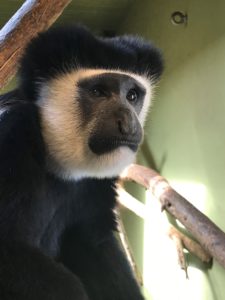ZOO CONTACT: Kyle Shepherd
502-238-5331 (Media Cell 502-744-5639)
kyle.shepherd@louisvilleky.gov
 The non-dangerous animal briefly ventured just outside of his exhibit.
The non-dangerous animal briefly ventured just outside of his exhibit.
Just after 10 a.m., one of the Zoo’s colobus monkeys, Rajesh (Raj), was observed by his keeper a few feet outside of the exhibit space. Colobus monkeys are considered a non-dangerous species and during this time, the safety of the Zoo’s guests, staff and animals was never compromised.
Guests were redirected away from the area to allow staff to focus on Raj and were never at risk. The Zoo’s highly trained staff immediately implemented a plan of action to ensure Raj’s safe return. The keeper staff were strategically placed to secure the perimeter and Raj returned safely on his own to the exhibit space around 11:30 a.m.
After Raj was safely returned to his exhibit space and an all clear was given, guests were able to continue their visit in the impacted area of the Zoo. All guests, staff and animals are safe and sound.
Raj’s venture a few feet outside of his exhibit has been attributed to the failure of a small transfer chute panel. Repairs are underway.
“The safety of our animals, guests and staff is our top priority,” said Louisville Zoo Director Dan Maloney. “Colobus monkeys do not pose any danger to humans, and Raj was not at any risk during his short venture outside of his exhibit space. Our team undergoes extensive training for emergency situations that may arise, and I am proud of our team’s swift work to return Raj to his exhibit space safely.”
Rajesh shares the Colobus exhibit with Sheldon and Leonard. They can be identified by their black-and-white coloration and flowing white tails.
About Colobus Monkeys
Male colobus monkeys weigh about 30 lbs. and females weigh about 20 lbs. Black and white colobus monkeys live in troops/social groups of about 3 to 15, and are considered one of the most strikingly marked primates
***
About the Louisville Zoo
Since 2011, under Mayor Fischer’s administration, the Louisville Zoo celebrated its 50th anniversary, opened nine new exhibits and attractions, and won national awards for Glacier Run and School at the Zoo. Considered Kentucky’s most popular not-for-profit paid attraction, the Zoo welcomed nearly 9 million guests in the last decade. In 2021, the Zoo was voted “Best Place to Take Kids in Summer,” by LEO Weekly, “Best Kid-Friendly Attraction” by Kentucky Living Magazine and Boo at the Zoo made the Top 10 Halloween Festivals list by thetravel.com. Community Access Memberships, deep-discount days, the Future Healers Got Zoo Buddies partnership and the accessible playground are among prime efforts to make Louisville Zoo even safer, more engaging, and more inclusive. Among the Louisville Zoo’s most successful conservation programs, the black-footed ferret breeding effort produced 1,100 kits and repatriated more than 800 of these most highly endangered, American mammals to the wild.
The Louisville Zoo, a non-profit organization and state Zoo of Kentucky, is dedicated to bettering the bond between people and our planet by providing excellent care for animals, a great experience for visitors, and leadership in scientific research and conservation education. The Zoo is accredited by the Association of Zoos and Aquariums (AZA).
# # #
